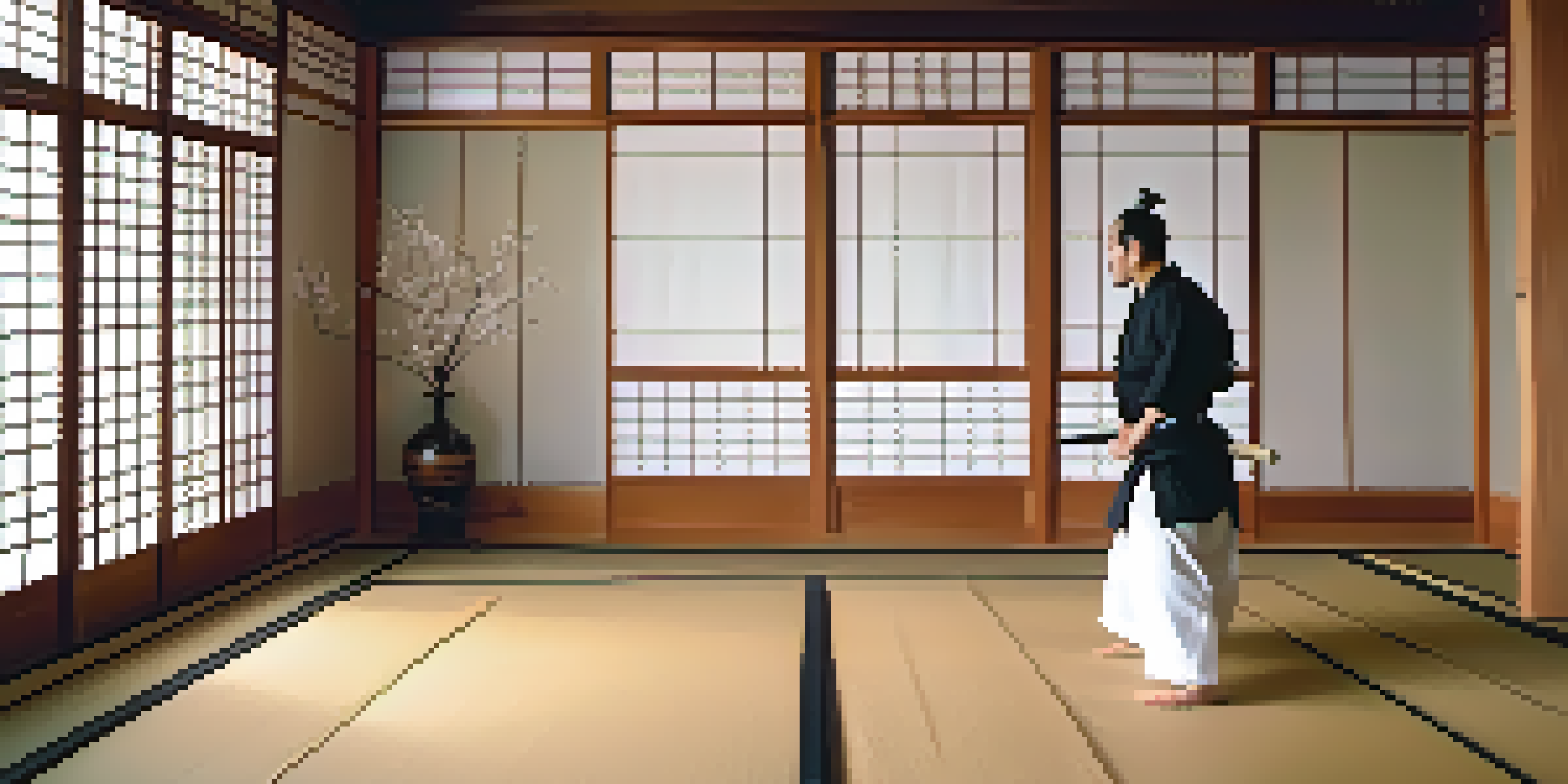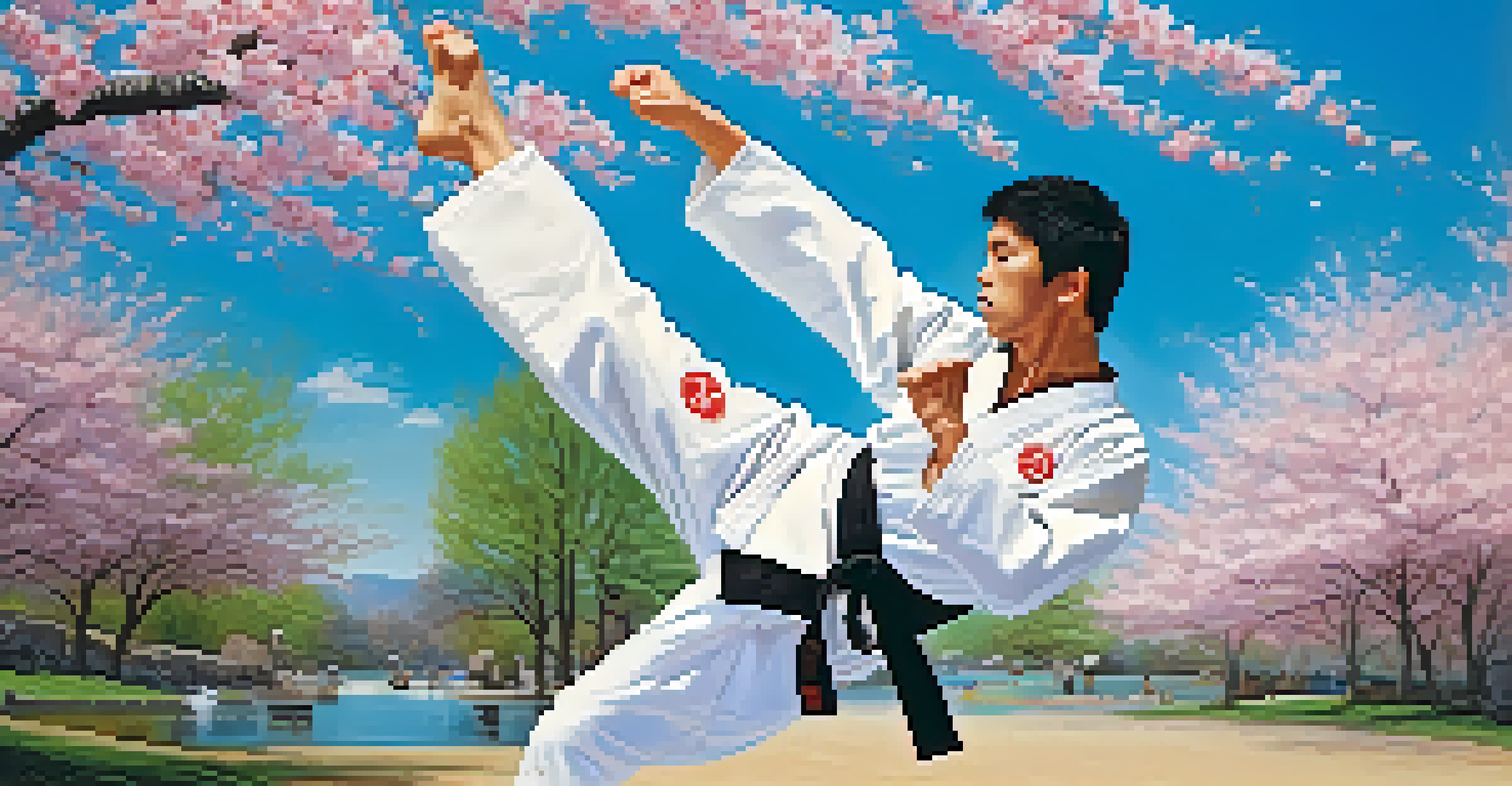Exploring Japanese Martial Arts as a Self Defense Strategy

Understanding the Essence of Japanese Martial Arts
Japanese martial arts encompass a variety of disciplines, each with its own unique philosophy and techniques. From the fluid movements of Aikido to the striking power of Karate, these arts offer a comprehensive approach to self-defense. The core principle is not just about physical strength; it's about harmony, balance, and utilizing an opponent's energy against them.
The ultimate aim of martial arts is not having to use them.
Many practitioners find that martial arts training cultivates mental resilience and discipline, which are crucial in high-stress situations. This mental fortitude can help individuals remain calm and make sound decisions when faced with danger. Additionally, the focus on respect and self-control in these arts promotes a mindset that prioritizes conflict avoidance whenever possible.
Ultimately, understanding the essence of these martial arts forms the foundation for effective self-defense strategies. They teach not only how to defend oneself physically but also how to navigate potentially dangerous situations with confidence and awareness.
Karate: The Art of Striking for Self-Defense
Karate is perhaps one of the most recognized Japanese martial arts, known for its powerful strikes and kicks. It emphasizes precise movements and quick reflexes, making it an effective choice for self-defense. Practitioners learn to deliver powerful blows while maintaining balance and control, which is essential in a real-life confrontation.

In addition to physical techniques, Karate training often includes sparring, which simulates real-world situations in a controlled environment. This practice helps students develop timing and distance management, crucial skills for defending against an attacker. Furthermore, the emphasis on discipline can enhance one’s ability to react swiftly and effectively under pressure.
Martial Arts Enhance Self-Defense Skills
Japanese martial arts provide practical techniques and philosophies that empower individuals to defend themselves effectively.
Overall, Karate equips individuals with striking techniques that can be invaluable in self-defense scenarios. By mastering these skills, practitioners can gain confidence in their ability to protect themselves, contributing to a greater sense of personal safety.
Judo: Utilizing Leverage and Technique
Judo stands out among martial arts due to its focus on throws and grappling techniques that rely on leverage rather than brute strength. This makes it accessible for individuals of all sizes and strengths. The fundamental philosophy of Judo is to use an opponent's energy against them, allowing smaller practitioners to effectively defend themselves against larger attackers.
In the middle of difficulty lies opportunity.
Training in Judo involves learning how to fall safely, which is a valuable skill in any self-defense situation. By mastering breakfalls, individuals can minimize injury if they are taken to the ground during an altercation. Additionally, the close-quarters combat skills developed in Judo can be incredibly useful when faced with an aggressive assailant.
Ultimately, Judo teaches practitioners how to remain calm and composed while executing techniques that neutralize threats. This strategic approach to self-defense not only equips individuals with practical skills but also fosters a sense of confidence and empowerment.
Aikido: The Art of Peaceful Resolution
Aikido is often described as the 'art of peace,' emphasizing the importance of resolving conflict without escalating violence. This martial art teaches practitioners to redirect an opponent's energy and use joint locks and throws to neutralize aggression. The philosophy behind Aikido is about harmony and finding a peaceful resolution, even in confrontation.
Training in Aikido fosters awareness of one’s surroundings and the ability to anticipate an attack. This heightened situational awareness can be a valuable asset in self-defense, as it encourages individuals to avoid potential threats before they escalate. Furthermore, the practice of Aikido promotes mental clarity and emotional control, essential qualities in stressful scenarios.
Training Builds Confidence and Resilience
Practicing martial arts fosters self-confidence and mental resilience, which are essential for navigating life's challenges.
In essence, Aikido provides a unique perspective on self-defense that prioritizes de-escalation and non-violence. By learning to blend with an opponent's movements, practitioners can effectively protect themselves while adhering to the principles of peace and respect.
Kendo: The Way of the Sword for Modern Self-Defense
Kendo, or 'the way of the sword,' is a modern Japanese martial art that uses bamboo swords and protective gear. While it may seem more combative than other forms, Kendo emphasizes discipline, strategy, and respect. The training involves learning footwork, strikes, and defensive techniques, which can be adapted to self-defense scenarios.
One of the key components of Kendo training is developing a strong mental focus. Practitioners learn to maintain composure under pressure, which is crucial in any self-defense situation. The sport also instills a sense of respect for one’s opponent, which can lead to more mindful and strategic encounters rather than reckless aggression.
Although Kendo is primarily a sport, the skills learned can translate into practical self-defense techniques. The emphasis on agility, timing, and control offers practitioners unique insights into how to effectively handle confrontational situations with confidence and poise.
The Role of Conditioning in Martial Arts Training
Conditioning is a vital aspect of martial arts training, impacting both physical capabilities and self-defense effectiveness. Regular practice enhances strength, flexibility, and endurance, all of which contribute to a practitioner’s ability to respond to threats. A well-conditioned body can execute techniques more efficiently, increasing the chances of successfully defending oneself.
Moreover, conditioning often involves cardiovascular training, which improves overall fitness levels. This not only benefits martial arts practice but also enhances one’s ability to react quickly during an emergency. Being physically fit can make a significant difference in self-defense situations, where stamina and agility are often key factors.
Choose the Right Martial Art for You
Selecting a martial art that aligns with your interests and goals is crucial for sustained engagement and skill development.
Ultimately, committing to a conditioning routine alongside martial arts training creates a balanced approach to self-defense. It ensures that practitioners are not only skilled in technique but also physically prepared to handle real-world challenges.
Building Confidence Through Martial Arts Practice
One of the most significant benefits of practicing Japanese martial arts is the boost in self-confidence that comes with skill development. As individuals progress through their training, they gain a sense of achievement that translates into other areas of life. This newfound confidence often leads to a greater sense of personal security and improved self-image.
Martial arts training also fosters a supportive community where individuals encourage each other’s growth. This camaraderie can help build social connections and reinforce a sense of belonging, further enhancing self-esteem. As practitioners face challenges together, they learn to rely on themselves and others, creating a strong support system.

In essence, the journey through martial arts not only equips individuals with practical self-defense skills but also instills a deep sense of confidence and resilience. This confidence can empower individuals to navigate life’s challenges with a greater sense of assurance.
Choosing the Right Martial Art for Your Self-Defense Needs
With so many Japanese martial arts available, choosing the right one for your self-defense needs can feel overwhelming. It's essential to consider personal goals, physical abilities, and preferences when selecting a martial art. Whether you’re looking for striking techniques, grappling skills, or an emphasis on conflict resolution, there’s a style that can meet your needs.
Visiting local dojos and observing classes can provide valuable insights into what each martial art entails. Many instructors offer trial classes, allowing potential students to experience the training culture firsthand. This can help in determining which environment and style resonate most with you, enhancing the likelihood of sticking with it long-term.
Ultimately, the best martial art for self-defense is one that aligns with your personal interests and goals. By engaging in a style that you enjoy, you're more likely to remain committed to your training, ensuring that you develop the skills necessary for effective self-defense.